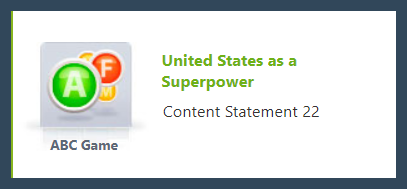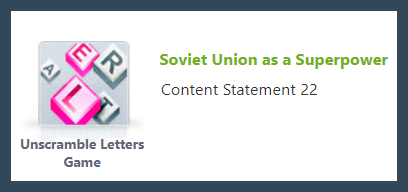The Cold War
(1945 - 1991)
Nuclear Age
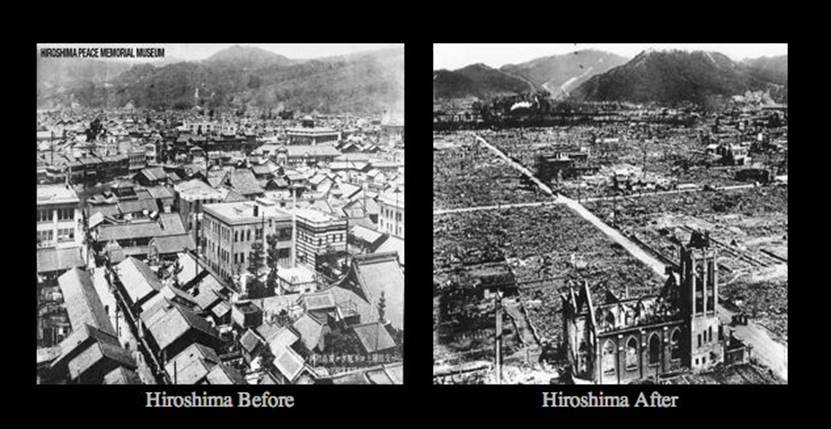
Figure 1† Atomic bomb at Hiroshima
Japan. Image. Britannica LaunchPacks, Encyclopedia Britannica, 8 Feb.
2020.
On August 9, 1945, three days after detonating a uranium-fueled
atomic bomb over Hiroshima, Japan,
the United States dropped a plutonium-fueled atomic bomb over
the Japanese port of Nagasaki.
†††† Content Statement #22
The use of
atomic weapons changed the nature of war, altered the balance of power, and
began the nuclear age.
††††††† Content
Elaborations
1.
The dropping of the atomic
bombs on Japan hastened the end of World War II and is considered the beginning
of the nuclear age. Atomic bombs introduced a new type of weapon capable of mass
destruction. Possession of the nuclear bomb contributed to the status of the
United States as a superpower.
2.
Successful Soviet development
of the atomic bomb in 1949 escalated an arms race that continued throughout the
Cold War and led to heightened fears of nuclear war and the establishment of
the Soviet Union as a second superpower.
Letís Practice:† Key Terms
†††††††
Section A: United States as a Superpower
During World
War II, the U.S. began a secret program known as the Manhattan Project to
develop atomic weapons. The first atomic bomb was dropped on Hiroshima, Japan
on August 6, 1945. This was followed by the dropping of the second atomic bomb
on Nagasaki on August 9. The dropping of atomic bombs on Japan led to the rapid
end of World War II in the Pacific.
The use of
atomic weapons changed the nature of war, altered the balance of power, and
began the nuclear age. The dropping of the atomic bombs in Japan is considered
the beginning of the nuclear period. The use of these bombs introduced a new
type of weapon capable of mass destruction.
In the four
years following World War II, the United States was the only country in
possession of atomic bombs, and this contributed to its status as a superpower.
|
Nuclear Arms Race Ė American Timeline |
||
|
1939 |
Albert Einstein and other scientists write a letter to
President Roosevelt urging him to take steps to be at the forefront of
nuclear weapons research so that other nations, such as Nazi Germany, donít
get there first. |
|
|
1941 |
President Roosevelt authorizes funding in secret for the Manhattan
Project; research begins at Columbia University and the University of
California at Berkeley. |
|
|
1942 |
The Manhattan Project relocates to Los Alamos, New Mexico. |
|
|
1945 |
July:† The Manhattan
Project successfully tests the first Atomic Bomb. President
Truman informs Stalin that the US has successfully built an atomic bomb
at the Potsdam conference thinking it would be a shock; Stalin already knew thanks
to Soviet spies in the United States. |
|
|
1945 |
August: The first two atomic bombs are dropped at Hiroshima
and Nagasaki by the United States to end the war with Japan, the bombs
kill approximately 200,000 people quickly. |
|
|
1948 |
Cold War has begun between the US and the Soviet Union. One of the
reasons attributed to the start of the Cold War was the fact that the US
didnít share atomic bomb-making technology with the Soviet Union, an ally at
the end of WWII, but did share it with other allies, including Great Britain. |
|
|
1949 |
NATO formed Ė a peacetime military alliance between the United
States, Canada, and Western European countries for collective security |
|
|
The late 1950s |
Both the US and the
Soviet Union have acquired enough
nuclear power to obliterate the other side. |
|
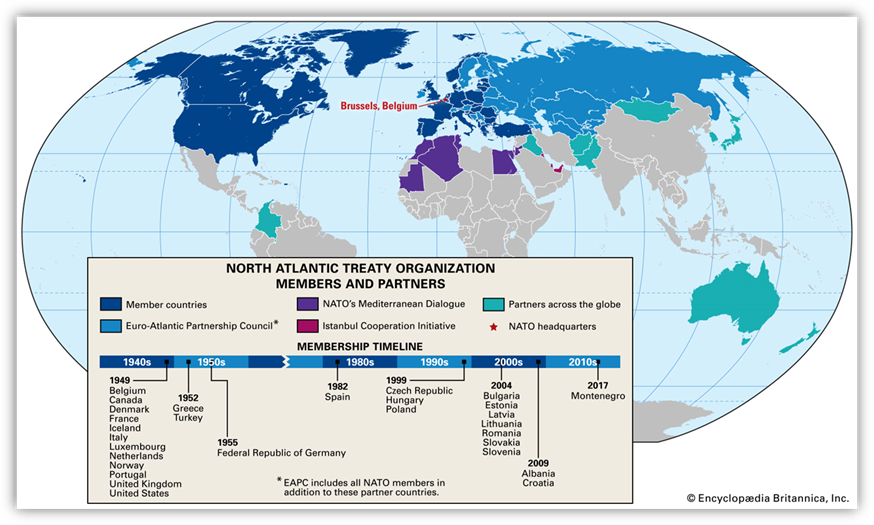
Letís Practice:† ABC Game
† Section B: Soviet Union as a
Superpower
For four
years following World War II, the United States was the only country in
possession of atomic bombs. This contributed to its status as a global
superpower. The threat of using this weapon was seen as a deterrent against the
ambitions of the Soviet Union.
The testing
and explosion of the atomic bomb by the Soviets in 1949 established the Soviet
Union as a second global superpower. In 1952, the U.S. tested its first
hydrogen bomb. Three months later, the Soviet Union tested its first
thermonuclear bomb, and by using lithium, they made a bigger bomb small enough
to fit into a plane. This nuclear arms race continued for decades and
threatened world peace.
|
Nuclear
Arms Race Ė Soviets Timeline |
||
|
1948 |
Cold War has begun between the US and the Soviet Union. One of the
reasons attributed to the start of the Cold War was the fact that the US
didnít share atomic bomb-making technology with the Soviet Union, an ally at
the end of WWII, but did share it with other allies, including Great Britain. |
|
|
1949 |
The Soviet Union tests its first atomic bomb. |
|
|
1955 |
Warsaw
Pact Ė Soviet bloc of collective security, a military
alliance in response to NATO formed. |
|
|
†The late 1950s |
Both the US and the
Soviet Union have acquired enough
nuclear power to obliterate the other side. |
|
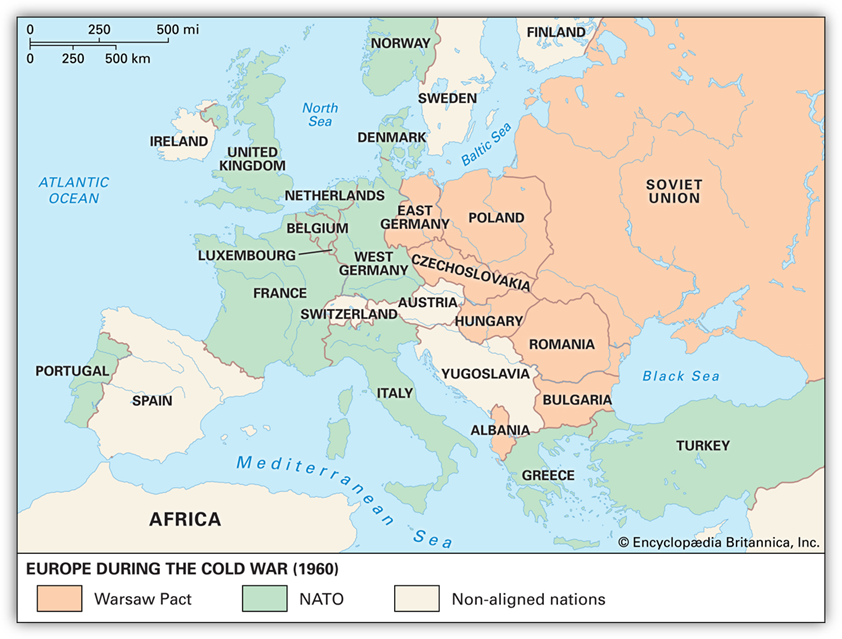
Letís Practice:† Unscramble
Letters Game
Section C:† Cold War Ideologies
Following
World War II, the United States and the Union of Soviet Socialist Republics
(Soviet Union) emerged as the two most influential powers in world affairs. The
U.S. and Soviet Union had opposing political and economic ideologies. The U.S.
was democratic and capitalist. The Soviet Union was communist. From 1945-1991,
the two nations challenged one another in a series of confrontations known as
the Cold War.
Not only did
the US and USSR compete with one another in proxy wars, but they also engaged
in a competition known as the Arms Race. Both countries looked to increase
their nuclear stockpile with newer and more powerful weapons. However, neither
side wanted to engage in a nuclear war that could destroy much of the world.
|
Cold War Ideologies |
||
|
Key Areas |
United States |
Soviet Union |
|
Economy |
Capitalism ∑ Private ownership of industry ∑ Freedom of competition |
Communism ∑ Government ownership of industry ∑ The goal is to bring economic equality to people |
|
Politics |
Democratic ∑ Government by the people ∑ Freedom of speech and press |
Totalitarian ∑ Government by one or a few ∑ No freedom of speech or press |
|
Key Values |
Freedom ∑ Based on individual rights |
Equality ∑ Everyone is equal |
|
Society |
Individual ∑ Competition is the best way to get to the top ∑ Stresses the need for people to do things on their own for
themselves |
Collective ∑ ďall for one, and one for all.Ē ∑ Emphasizes the need for people to do things together to
benefit the whole |
Letís Practice:† Video
Quiz

Click here to
watch a video and complete a quiz on The Cold War.
†††††††††††††††
